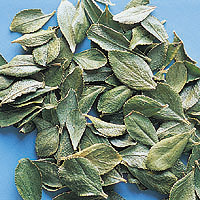Buchu
Uses
Parts Used & Where Grown
Buchu is a low shrub native to the Cape region of South Africa. The dried leaves are harvested during the flowering season. The oil can be obtained by steam distillation of the leaves. The two primary species of buchu used commercially are Agathosma betulina (syn. Barosma betulina) and Agathosma crenulata (syn. Barosma crenultata).
Our proprietary “Star-Rating” system was developed to help you easily understand the amount of scientific support behind each supplement in relation to a specific health condition. While there is no way to predict whether a vitamin, mineral, or herb will successfully treat or prevent associated health conditions, our unique ratings tell you how well these supplements are understood by the medical community, and whether studies have found them to be effective for other people.
For over a decade, our team has combed through thousands of research articles published in reputable journals. To help you make educated decisions, and to better understand controversial or confusing supplements, our medical experts have digested the science into these three easy-to-follow ratings. We hope this provides you with a helpful resource to make informed decisions towards your health and well-being.
3 StarsReliable and relatively consistent scientific data showing a substantial health benefit.
2 StarsContradictory, insufficient, or preliminary studies suggesting a health benefit or minimal health benefit.
1 StarFor an herb, supported by traditional use but minimal or no scientific evidence. For a supplement, little scientific support.
This supplement has been used in connection with the following health conditions:
| Used for | Why |
|---|---|
1 Star Urinary Tract Infection Refer to label instructions | Buchu leaf preparations have been historically used as a urinary tract disinfectant and diuretic. leaf preparations have a history of use in traditional herbal medicine as a urinary tract disinfectant and diuretic. However, the German Commission E monograph on buchu concludes that insufficient evidence supports the modern use of buchu for the treatment of UTIs or inflammation. |
Traditional Use (May Not Be Supported by Scientific Studies)
Buchu leaf preparations have a long history of use in traditional herbal medicine as a urinary tract disinfectant and diuretic.1 Buchu was used by herbalists to treat urinary tract infections and inflammation, as well as inflammation of the prostate. In Europe, it was also used to treat gout.2 The original use of buchu by the native peoples of southern Africa is unclear because buchu is a general term for aromatic plants.3 It appears to have been applied topically, possibly as an insect repellant, and also used internally for stomach problems, rheumatism and bladder problems.
How It Works
How It Works
The leaves of buchu contain 1.0–3.5% volatile oils as well as flavonoids.4 The urinary tract antiseptic actions of buchu are thought to be due to the volatile oils. The primary volatile oil component thought to have antibacterial action is the monoterpene disophenol. However, one test tube study using buchu oil found no significant antibacterial effect.5
How to Use It
The German Commission E Monograph concludes there is insufficient evidence to support the modern use of buchu for the treatment of urinary tract infections or inflammation.6 However, some traditional herbal practitioners continue to recommend the herb for these conditions. Traditional recommendations for the herb include the use of 1–2 grams of the dried leaf taken three times daily in capsules or in a tea.7 Tinctures can be used at 2–4 ml three times per day.
Interactions
Interactions with Supplements, Foods, & Other Compounds
Interactions with Medicines
Certain medicines interact with this supplement.
Replenish Depleted Nutrients
none
Reduce Side Effects
none
Support Medicine
none
Reduces Effectiveness
none
Potential Negative Interaction
Explanation Required
none
Side Effects
Side Effects
Buchu may cause gastrointestinal irritation and should only be taken with meals. Also, it should not be used by pregnant or breast-feeding women.
References
1. Leung AY, Foster S. Encyclopedia of Common Natural Ingredients Used in Food, Drugs and Cosmetics. New York: John Wiley and Sons, 1996, 104-5.
2. Gruenwald J, Brendler T, Jaenicke C, et al. (eds). PDR for Herbal Medicines. Montvale, NJ: Medical Economics, 1998, 686-7.
3. Simpson D. Buchu--South Africa's amazing herbal remedy. Scott Med J 1998;43:189-91 [review]
4. Wichtl M. Herbal Drugs and Phytopharmaceuticals. Boca Raton, FL: CRC Press, 1994, 102-3.
5. Didry N, Pinkas M. A propos du Buchu. Plantes Méd et Phyothér 1982;16:249-52.
6. Blumenthal M, Busse WR, Goldberg A, et al. (eds). The Complete German Commission E Monographs: Therapeutic Guide to Herbal Medicines. Austin: American Botanical Council and Boston: Integrative Medicine Communications, 1998, 317.
7. Bradley PR (ed). British Herbal Compendium, vol 1. Bournemouth, England: British Herbal Medicine Association, 1992, 43-5.
Last Review: 05-24-2015

Copyright © 2024 TraceGains, Inc. All rights reserved.
Learn more about TraceGains, the company.
The information presented by TraceGains is for informational purposes only. It is based on scientific studies (human, animal, or in vitro), clinical experience, or traditional usage as cited in each article. The results reported may not necessarily occur in all individuals. For many of the conditions discussed, treatment with prescription or over the counter medication is also available. Consult your doctor, practitioner, and/or pharmacist for any health problem and before using any supplements or before making any changes in prescribed medications. Information expires December 2024.
This information does not replace the advice of a doctor. Healthwise, Incorporated, disclaims any warranty or liability for your use of this information. Your use of this information means that you agree to the Terms of Use. Learn how we develop our content.

